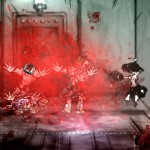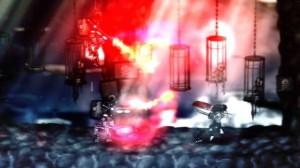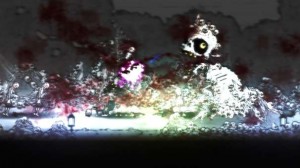 One of the great things about Xbox Live arcade, Apples App store and PSN is that they all offer an opportunity for a young, creative game developer to achieve their dream: to create a successful game of their own. Young James Silva did just that in April 2009 when The Dishwasher: Dead Samurai was released. It was a fun, stylish and humorously twisted 2D fighting game with splendidly bloody, gore soaked combat.
One of the great things about Xbox Live arcade, Apples App store and PSN is that they all offer an opportunity for a young, creative game developer to achieve their dream: to create a successful game of their own. Young James Silva did just that in April 2009 when The Dishwasher: Dead Samurai was released. It was a fun, stylish and humorously twisted 2D fighting game with splendidly bloody, gore soaked combat.
With The Dishwasher: Vampire Smile, James Silva’s company “Ska Studios” have created a game that builds on the original in every way. The result is a great premise taken to ludicrous new levels of complexity, depth and violence. If the first game simply introduced the concepts of the Dishwasher Samurai, the sequel takes them so far and adds so much its difficult to see how they can possibly up the level of moves, animations, bloody dismemberments and gameplay intricacies in a third game.
 The first thing that you notice about the game is its stunning presentation and art direction. With a black and white aesthetic similar to Limbo, it looks stunning. Cut scenes look very much like the best bits of Frank Miller’s Sin City while the combination of black and white, line drawn characters and environments with bright red blood are very much like the Wii game Mad World. The level of carnage is similar to that game too with buckets of blood being spilled and limbs falling off all over the place. The story is dark, twisted and nightmare-like.
The first thing that you notice about the game is its stunning presentation and art direction. With a black and white aesthetic similar to Limbo, it looks stunning. Cut scenes look very much like the best bits of Frank Miller’s Sin City while the combination of black and white, line drawn characters and environments with bright red blood are very much like the Wii game Mad World. The level of carnage is similar to that game too with buckets of blood being spilled and limbs falling off all over the place. The story is dark, twisted and nightmare-like.
The gameplay is superficially similar to Shank with side scrolling gunplay, sword swipes, chainsaws and combos. As you learn the combat systems though, it becomes closer to something like Viewtiful Joe with similar, high levels of difficulty. Although similar to that game in the way that you gain slow motion as you achieve longer combos, its still an inaccurate comparison as there’s so much thats unique about The Dishwash: VS’s combat. There’s unbelievable depth, many characters and weapons to choose from as well as magic, machine guns and weapon load outs. The fundamental defenseive move is to teleport a short ditance in a puff of smoke (or blood) and its a great mechanic. It makes battles seem more like martial arts movies than it would if the player spent time blocking attacks. It also makes the player more aggresive; time isn’t spent waiting, blocking and countering, but rather warping away and attacking enemies from all angles.
 With a weak and strong attack, jumping, running on walls, teleporting, weapon loadouts, weapon choices, character choices, customisation, magic, counters, complex combos, dashes and more, it feels like the game is designed for those who will put in the time to learn how to exploit the thousands of combinations available. This is to the detriment of the beginner though. It can be massively overwhelming and the help systems tend to encourage experimentation in the player rather than actively guiding them. After a while it begins to click and when you clear rooms of enemies in long, balletic, unbroken combos its glorious. Sliding past enemies in a blur and then pausing only to watch their heads all fall off from your invisible sword-stroke never gets old.
With a weak and strong attack, jumping, running on walls, teleporting, weapon loadouts, weapon choices, character choices, customisation, magic, counters, complex combos, dashes and more, it feels like the game is designed for those who will put in the time to learn how to exploit the thousands of combinations available. This is to the detriment of the beginner though. It can be massively overwhelming and the help systems tend to encourage experimentation in the player rather than actively guiding them. After a while it begins to click and when you clear rooms of enemies in long, balletic, unbroken combos its glorious. Sliding past enemies in a blur and then pausing only to watch their heads all fall off from your invisible sword-stroke never gets old.
Before you get to that point there’s a lot of confusion and frustration though. Its a hard game and in truth even now I rarely feel fully aware of what’s going when I play, even after many hours of practice. To some extent it becomes instinctual, but it’s often hard to see what is happening on screen and you tend to search for audio cues as much as visual ones. An early zombie-boss was a particular low point as the action becomes far too frenetic for me to know where I was or what was happening. Happening at such an early stage, its easy to see how gamers could give up at this point out of sheer confusion.
 Rounding out the package is a great variety of different modes to explore. There’s a competitive multiplayer mode that makes it even harder to follow the on-screen action, but is fun nonetheless. Competitive leaderboards and arcade modes that pit you against waves of enemies seem like they will be important to the competitive fan base and if you’re competitive in those domains, the game could give hundreds of hours of entertainment. For an Xbox Live Arcade title, that’s unbelievable value for money.
Rounding out the package is a great variety of different modes to explore. There’s a competitive multiplayer mode that makes it even harder to follow the on-screen action, but is fun nonetheless. Competitive leaderboards and arcade modes that pit you against waves of enemies seem like they will be important to the competitive fan base and if you’re competitive in those domains, the game could give hundreds of hours of entertainment. For an Xbox Live Arcade title, that’s unbelievable value for money.
Even the music is great. Interspersed between the moody cinematics and gameplay there’s a great soundtrack that flips between industrial metal to solo-heavy rock. The great music even extends to fun mini games like a Guitar Hero quicktime event with an awesome, face-melting guitar solo.
The truly impressive thing about The Dishwasher: Vampire Smile is that its a pure representation of what its creator intended. This isn’t a game made by committee; quite the opposite. It’s the work of an auteur and this sequel makes no compromises. Instead it ups the violence, complexity and outright creative bravery of its predecessor. Its wonderful.
8 twenty-thousand-hit combos out of 10
